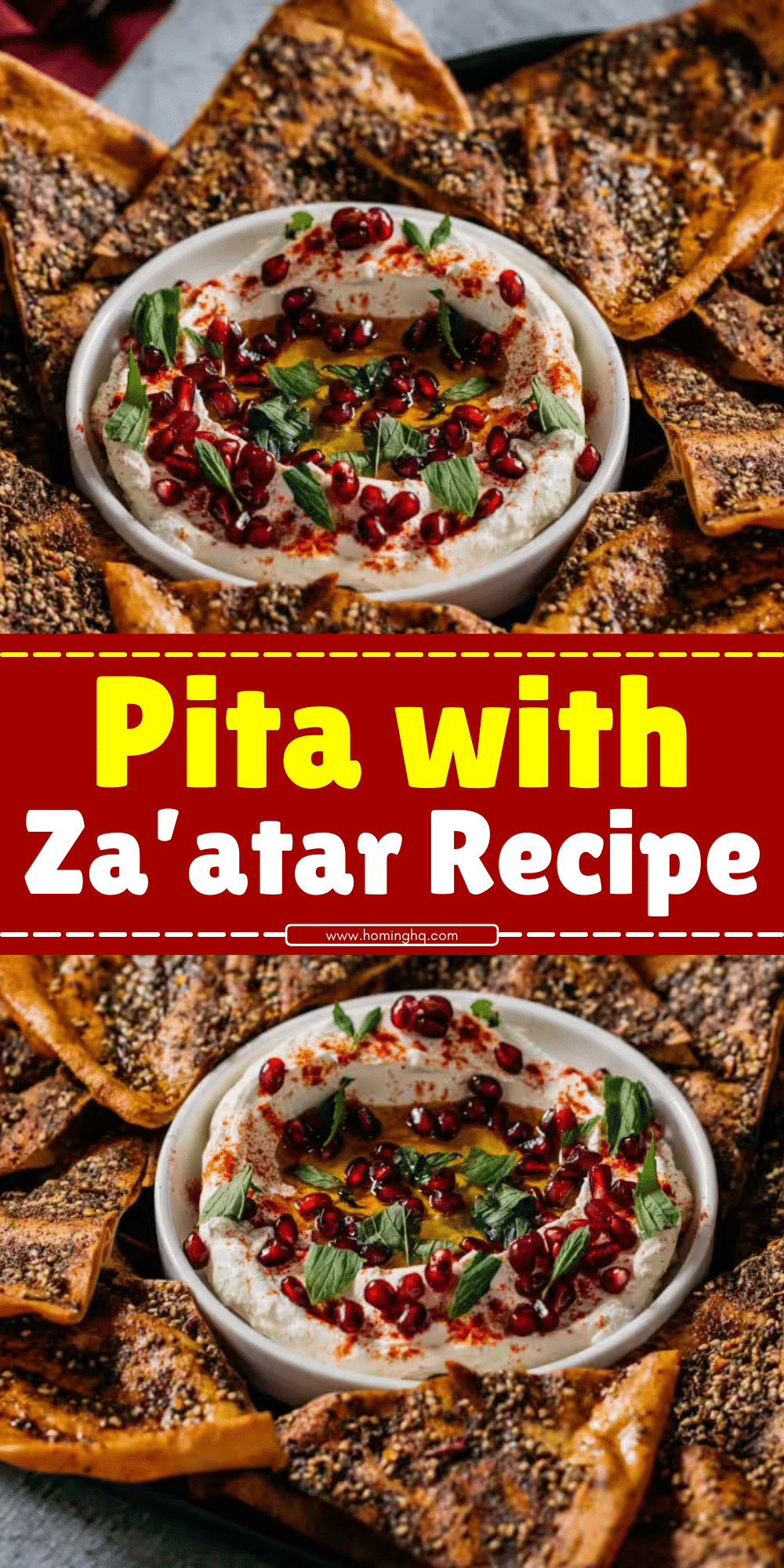If you’ve ever tasted the combination of warm, fluffy pita bread topped with aromatic za’atar, you know it’s an unforgettable experience.
This simple yet flavorful dish has become a beloved staple in Middle Eastern cuisine, bringing together the soft texture of pita and the rich, herbaceous notes of za’atar.
Whether you’re serving it as a quick snack, part of a larger mezze platter, or as a side to a main dish, pita with za’atar is an easy-to-make treat that’s full of flavor and tradition.
In this blog, we’ll dive into the history and essence of za’atar, explore why it pairs so wonderfully with pita, and guide you step-by-step through making this delightful dish at home.
Whether you’re a seasoned cook or a beginner, this recipe is simple, delicious, and perfect for any occasion.

What is Za’atar? Understanding the Spice Blend
Za’atar is more than just a spice—it’s a whole experience. This iconic Middle Eastern herb blend is made up of several key ingredients that work together to create its distinct, earthy, and tangy flavor.
The primary components typically include dried thyme, oregano, sumac, and sesame seeds, although regional variations might add different herbs or spices to suit local tastes.
The sumac gives za’atar its signature tartness, while the sesame seeds add a crunchy texture and a subtle nuttiness. The thyme and oregano offer a herbaceous quality that balances the blend.
Za’atar is incredibly versatile and is used not just on pita bread but also as a seasoning for meats, vegetables, and dips.
In some regions, you might find za’atar sold pre-mixed, or you can easily make your own by combining these ingredients in specific ratios.
This simple yet flavorful blend is part of the heart and soul of Middle Eastern cooking, making it a beloved addition to many meals.
Why Pita and Za’atar Make the Perfect Combination
There’s something magical about the combination of pita and za’atar. Pita, with its soft, pillowy texture, acts as the perfect vessel to carry the bold, complex flavors of the za’atar blend.
The fluffy interior of the pita soaks up the olive oil mixed with za’atar, while the slightly crispy edges add a delightful crunch when toasted.
Za’atar’s herbal and tangy notes pair beautifully with the subtle flavor of pita, creating a simple yet satisfying bite.
The balance between the freshness of the herbs, the tartness of sumac, and the nutty richness of sesame seeds complements the soft bread, making each bite a comforting experience.
Together, they create a dish that is not only easy to prepare but incredibly flavorful, making it a go-to snack or appetizer in Middle Eastern cuisine.
Plus, the blend of warm pita with the aromatic za’atar is versatile—whether served warm or at room temperature, it’s always a crowd-pleaser.
Ingredients You’ll Need for Pita with Za’atar
Making pita with za’atar requires just a few simple ingredients that you might already have in your kitchen. Here’s what you’ll need:
For the Pita:
You can use store-bought pita bread or make your own from scratch, but the key is to ensure the pita is fresh and soft for the best texture. If using store-bought pita, be sure to get a good quality variety, preferably from a bakery or specialty store.
For the Za’atar Blend:
- Za’atar Spice Mix – If you have access to ready-made za’atar, you’re all set. Otherwise, you can make your own by combining:
- 2 tablespoons dried thyme
- 1 tablespoon sesame seeds (lightly toasted for more flavor)
- 1 tablespoon sumac
- 1 teaspoon oregano (optional)
- 1/2 teaspoon salt
- Olive Oil – A good quality extra virgin olive oil is essential for the richness and smoothness it adds to the za’atar mix.
Step-by-Step Instructions for Making Pita with Za’atar

Now that you have your ingredients ready, it’s time to bring this delicious dish to life. Follow these simple steps to create perfect pita with za’atar.
Step 1: Preparing the Za’atar Mixture
In a small bowl, combine the za’atar spices. If you’re making your own blend, mix the dried thyme, sesame seeds, sumac, and salt together. Adjust the proportions to suit your taste. For a smoother, more spreadable consistency, add 2-3 tablespoons of olive oil to the mixture and stir until well combined. The olive oil will help the za’atar stick to the pita and give it a glossy finish when baked or toasted.
Step 2: Preparing the Pita
If you’re using store-bought pita, gently warm it up in a dry skillet over medium heat or wrap it in a damp paper towel and microwave it for 10-15 seconds. If you’re feeling adventurous and have some time, you can also make fresh pita bread. The key here is to use warm pita so that it absorbs the za’atar mixture more easily and provides a better texture.
Step 3: Assembling the Pita with Za’atar
Once the pita is warm, place it on a flat surface and use a spoon to generously spread the za’atar mixture over the top. Make sure to spread it evenly so that every bite has that delicious, aromatic flavor. You can use a brush for a more even coat, but a spoon works just fine.
Step 4: Baking or Toasting (Optional)
For an extra crispy finish, place the za’atar-coated pita in the oven or on a skillet. To bake, preheat the oven to 375°F (190°C) and place the pita directly on the oven rack for about 5-7 minutes or until the edges are golden and slightly crispy. If you prefer to toast it on the stovetop, heat a skillet over medium-low heat and toast the pita for about 2-3 minutes per side until the edges are crisp and the za’atar becomes fragrant.
Variations on the Classic Pita with Za’atar
While pita with za’atar is delicious in its simplest form, there are many creative ways to elevate or personalize the dish. Here are a few variations you can try to add some extra flavor or texture:
1. Add Cheese for a Richer Flavor
Transform your pita with za’atar into a more indulgent treat by adding cheese. You can sprinkle feta cheese on top of the za’atar before toasting for a salty, tangy kick. Alternatively, try adding mozzarella for a gooey, melt-in-your-mouth experience. The cheese adds richness that balances beautifully with the herbal notes of the za’atar.
2. Pita with Za’atar and Vegetables
For a more wholesome version, top your pita with za’atar and a selection of fresh vegetables. Tomatoes, cucumbers, and red onions are all great choices, adding freshness and crunch. You can even add roasted vegetables like eggplant, zucchini, or bell peppers for a savory twist. These veggies complement the za’atar’s earthy flavors, making it a more filling meal.
3. Meat Lovers’ Pita with Za’atar
For those who enjoy a heartier meal, grilled chicken or lamb pairs wonderfully with pita and za’atar. Simply slice the meat and place it on top of the za’atar-covered pita before toasting or serving. The combination of za’atar’s tangy and herbaceous flavor with the savory, juicy meat makes for a satisfying dish that can stand as a meal on its own.
4. Pita with Za’atar and a Dollop of Yogurt
To cool down the spices and add a creamy element, serve your pita with a side of Greek yogurt or labneh. The yogurt adds a tangy, creamy contrast that enhances the flavors of the za’atar and complements the texture of the warm pita. You can either drizzle the yogurt on top or serve it on the side as a dip.
5. Sweet Twist on Za’atar
If you’re feeling adventurous, experiment with a sweeter twist by sprinkling a bit of honey or date syrup over the za’atar-coated pita after toasting. The subtle sweetness combined with the herbal and nutty flavors of za’atar creates an intriguing contrast that works beautifully as a snack or dessert option.
Storing Leftovers and Making Pita with Za’atar Ahead of Time
Making pita with za’atar is quick and easy, but sometimes you may want to make it ahead of time or store leftovers for later enjoyment. Here’s how to ensure your pita stays fresh and flavorful:
Storing Leftovers
If you happen to have leftover pita with za’atar, it’s best to store it properly to keep it tasting fresh. Simply place the leftover pita in an airtight container or wrap it in aluminum foil to preserve its moisture. Store it in the refrigerator for up to 2-3 days. Keep in mind that while the flavors will still be there, the texture of the pita will soften as it sits.
Reheating Leftover Pita with Za’atar
To bring back the fresh, crispy texture, you can easily reheat your pita with za’atar. For the best results, place the pita on a baking sheet in a preheated oven at 350°F (175°C) for about 5-7 minutes, or until warmed through and slightly crisp. Alternatively, heat it in a skillet over medium heat for a few minutes on each side.
Making Pita with Za’atar Ahead of Time
If you’re planning ahead, you can prepare the za’atar mix and store it in an airtight jar for up to a month, so it’s ready to go when you want to make the dish. You can also prepare the pita bread in advance if you’re making it from scratch—just be sure to let it cool completely before storing it in a sealed bag or container. When you’re ready to assemble the dish, all you need to do is warm the pita, spread the za’atar mixture, and bake or toast it.
Freezing Pita with Za’atar
If you have leftover pita with za’atar that you want to freeze, it’s possible to store it in the freezer. After assembling the pita with the za’atar and olive oil, wrap it tightly in plastic wrap or foil and place it in a freezer-safe bag. When ready to enjoy, reheat directly from frozen in the oven or skillet. However, freezing may slightly affect the texture of the pita, so it’s best enjoyed fresh when possible.
By following these simple storage tips, you can enjoy pita with za’atar over several days or even prep it ahead of time for convenience.
Final Thoughts
Pita with za’atar is a wonderfully simple yet flavorful dish that captures the essence of Middle Eastern cuisine. Whether you’re craving a quick snack or looking for a light appetizer to share with friends, this dish delivers on both taste and convenience. The combination of warm, soft pita with the aromatic, tangy za’atar makes for a bite that is comforting, satisfying, and full of character.
The beauty of pita with za’atar lies in its versatility—you can enjoy it as is, or customize it with your favorite toppings, from cheese and veggies to grilled meats and creamy dips. It’s a dish that invites experimentation, and it’s perfect for both casual gatherings and more formal occasions. Plus, making it at home means you get to adjust the flavors to your liking.
So next time you’re in the mood for something delicious and easy, reach for some pita and za’atar. With minimal ingredients and just a few steps, you’ll have a dish that’s sure to impress.
Frequently Asked Questions (FAQ)
1. Can I use a different bread instead of pita?
Yes, you can use other types of flatbread, like lavash or naan, if pita isn’t available. However, pita’s fluffy texture and pockets make it the perfect choice for soaking up the za’atar mixture. Just keep in mind that other types of bread may not have the same lightness.
2. What if I don’t have all the za’atar ingredients?
If you’re missing one or two ingredients from the za’atar mix (such as sumac or sesame seeds), you can still make a decent blend with what you have. For example, thyme, oregano, and a bit of salt will still work, though the final flavor may be less complex. You can also try adding a splash of lemon juice if you don’t have sumac to mimic the tartness.
3. Can I freeze pita with za’atar?
While you can freeze pita with za’atar, it’s best to do so before it’s baked or toasted. After spreading the za’atar mixture on the pita, wrap it tightly and freeze. When you’re ready to eat, simply bake it from frozen for a quick snack.
4. How spicy is za’atar?
Za’atar is typically not spicy at all. It’s more about the herby, tangy flavors of the thyme, sumac, and sesame seeds. If you want to add some heat, you can sprinkle a pinch of chili flakes or add some hot sauce on top of your pita before serving.
5. Can I make pita with za’atar in advance?
Yes, you can prepare the za’atar mixture and even the pita in advance. Store the za’atar mix in an airtight container, and you can even prepare the pita ahead of time. Just warm it up and add the za’atar before toasting or baking it when you’re ready to serve. If you’re making it for a party, this is a great way to save time on the day of.

Pita with Za’atar
Equipment
- 1 bowl (for mixing za'atar)
- 1 spoon or brush (for spreading the za'atar)
- 1 skillet or baking sheet (for toasting or baking the pita)
- 1 oven or stovetop (for baking or toasting the pita)
Ingredients
- 4-6 pita breads
- 2 tablespoons dried thyme
- 1 tablespoon sesame seeds
- 1 tablespoon sumac
- 1 teaspoon oregano optional
- 1/2 teaspoon salt
- 3 tablespoons olive oil extra virgin preferred
Instructions
- Prepare the Za’atar Mixture: In a small bowl, combine the dried thyme, sesame seeds, sumac, oregano (if using), and salt. Add the olive oil to the mixture and stir until well combined. The olive oil should help the spices stick to the pita and give it a rich, glossy finish.
- Prepare the Pita: Warm the pita by either toasting it in a skillet over medium heat for 1-2 minutes per side or microwaving it for 10-15 seconds wrapped in a damp paper towel. If using fresh homemade pita, make sure it’s soft and warm.
- Assemble the Pita: Lay the warm pita flat on a cutting board or plate. Use a spoon or brush to spread the za’atar mixture evenly over the top of the pita, ensuring a generous coating.
- Toast or Bake the Pita: If toasting, place the pita in a hot skillet and cook for 2-3 minutes on each side, until the edges are crispy and golden. Alternatively, preheat your oven to 375°F (190°C) and bake the pita for 5-7 minutes until it’s crisp and fragrant.
- Serve: Once the pita is toasted or baked, cut it into wedges and serve warm. You can enjoy it as a stand-alone snack or pair it with dips like hummus or baba ganoush.
Notes
- Za’atar Variations: Za’atar blends can vary by region. Feel free to experiment with additional ingredients like sumac, thyme, or even ground coriander for different flavor profiles.
- Make it Veggie: Add some fresh veggies like cucumber, tomato, or red onion on top of the za’atar for extra freshness.
- Cheese: For a richer version, top your pita with feta cheese or mozzarella before toasting or baking.
- Storage: Leftovers can be stored in an airtight container at room temperature for 1-2 days. Reheat in the oven or skillet to maintain crispness.

